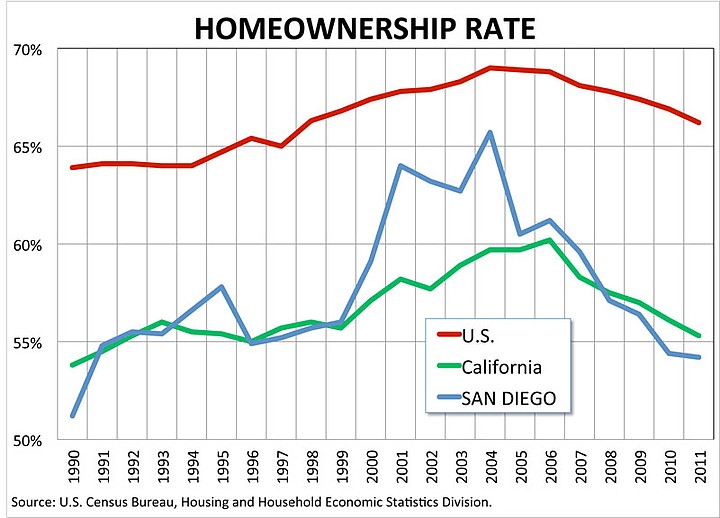 Facebook
Facebook
 X
X
 Instagram
Instagram
 TikTok
TikTok
 Youtube
Youtube

A recovering economy normally requires a robust housing revival, strong employment gains, and consumer spending fired by sharply rising incomes. Sorry. San Diego has none of these, although there are occasional transient statistical gains that spark hope, which quickly burns out.
Recent home-price data in the county have suggested that prices are inching up each month. Don’t be fooled. Even with interest rates at startlingly low levels, “It’s a tough market. We are still seeing foreclosures. We are not seeing investment in [projects] with greater density or some sort of mixed-use projects,” says Chuck Flacks, research director of the San Diego Workforce Partnership.

Kelly Cunningham, economist for the National University System Institute for Policy Research, agrees that “it’s hard to see a recovery in housing — maybe we will bounce along the bottom.” Historically, a high percentage of San Diegans have been renters, not buyers. Two decades ago, 55 percent of San Diego households owned homes versus 64 percent nationally. San Diego spiked past 65 percent in the bubble years but is now below 55 percent.
In those bubble years, real estate (buying, selling, leasing, building) was 21 percent of the San Diego economy, one of the highest such percentages in the nation. It’s probably below 16 percent now, says Cunningham.
He notes that more and more people between 25 and 34 are living with parents. Nationally, in 1983 only 10.5 percent of people in that age group lived with parents. That has shot up to almost 14.5 percent. There are no comparable local numbers, but the average household size has grown to 2.78, partly because of young people living at home and partly because of the rise in the number of Hispanic families, which are larger.
San Diego County home values have dropped 40 percent from their late 2005–early 2006 peaks, “and I don’t think in our lifetimes we will get back to those boom-period peaks,” says Cunningham. Despite the plunge, San Diego prices are still very high. According to Zillow, the county’s median home value is $338,100, topping New York City, Boston, and Washington, D.C., among the largest 30 markets, and trailing only San Jose, Los Angeles, and San Francisco.
And those high local home prices present a problem with San Diego incomes on the anemic side. In 2010, total personal income (including salaries, investment and rental income, Social Security, and the like) was up 1.2 percent adjusted for inflation. Last year, Cunningham estimates that it was flat after inflation adjustment.
And the flaccid income figures, in turn, wallop consumer spending. County retail sales peaked in 2006 at $47.8 billion, says Cunningham. Last year, sales had dropped to $44.3 billion. Adjusted for inflation and population growth, sales would be even weaker, he says.
Baby boomers, that cohort born between 1946 and 1964, are now starting to retire in large numbers. That trend will escalate. “Of that big wave of baby boomers, fewer are working now,” says Cunningham. “They are not out spending, buying new clothes or furniture, going out to eat as much. And a lot of them are migrating from San Diego” to places with a lower cost of living.
“In the last recession we lost a lot of middle-class jobs,” says Alan Gin, economist at the University of San Diego, and that has weakened consumption. Politicians on the federal, state, and local levels are cutting government services. That, in turn, hurts consumers. “Austerity exacerbates the problem,” says Gin, and the U.S. should learn from the experience in Europe. Massive spending cuts in beleaguered countries such as Greece are weakening economies, and tax receipts actually fall.
Governor Jerry Brown’s new budget will cut social services, no matter how the legislature and voters alter the program by, say, nixing the tax increases. So that’s another negative for San Diego. New Jersey–based economist A. Gary Shilling points out that state and local spending is normally around 13 percent of the nation’s yearly economic output, second behind consumer spending, which is 71 percent. Gin expects that such spending will continue falling in San Diego, further denting the economy.
Then there is federal spending. From 2001 through 2011, total military spending — uniformed and non-uniformed personnel, base expenditures, aerospace-defense manufacturing — doubled, notes Cunningham. But 2010 may have been the peak. “It’s drifting downward,” he says. Total defense spending is 12 percent of the local economy, 20 percent including the ripple effect (supplier sales, for example). There was a lot of construction at Camp Pendleton that is now running its course.
San Diego is “the epicenter” of drone manufacturing, but those gains are offset by declines in shipbuilding and other industries. “Computer electronics defense manufacturing is slipping,” he says.
But defense is likely to remain a fortress of the local economy. Nationally, “the big cuts will fall on the Army rather than the Navy,” says Gin, noting that the military is slowly moving its operations to the western part of the U.S.
San Diego’s unemployment rate continues higher than the nation’s: in April it was 8.7 percent compared to the nation’s 7.7 percent. “Faster growth was being predicted around the first of the year,” says Flacks. “Some of the earlier growth expectations are being realized, but we are not seeing the same growth in employment.”
Health-care employment remains strong, as new hospitals are being built. “But a lot depends on the ruling of the Supreme Court [on what’s called Obamacare].” Despite all the fiscal problems, “I think California may be well on its way to doing something like Massachusetts — an Obamacare-type proposal for the state.”
Cunningham says tech and biotech account for 10 percent of jobs directly and 30 percent indirectly. Tech employment “is showing some gains, but it is fairly weak,” he says. “Some sectors are growing: biotech and software are showing some gains, but telecom and communications are on a downswing that puzzles me.”
All told, the local economy is “moving at a snail’s pace,” says Gin.


A recovering economy normally requires a robust housing revival, strong employment gains, and consumer spending fired by sharply rising incomes. Sorry. San Diego has none of these, although there are occasional transient statistical gains that spark hope, which quickly burns out.
Recent home-price data in the county have suggested that prices are inching up each month. Don’t be fooled. Even with interest rates at startlingly low levels, “It’s a tough market. We are still seeing foreclosures. We are not seeing investment in [projects] with greater density or some sort of mixed-use projects,” says Chuck Flacks, research director of the San Diego Workforce Partnership.

Kelly Cunningham, economist for the National University System Institute for Policy Research, agrees that “it’s hard to see a recovery in housing — maybe we will bounce along the bottom.” Historically, a high percentage of San Diegans have been renters, not buyers. Two decades ago, 55 percent of San Diego households owned homes versus 64 percent nationally. San Diego spiked past 65 percent in the bubble years but is now below 55 percent.
In those bubble years, real estate (buying, selling, leasing, building) was 21 percent of the San Diego economy, one of the highest such percentages in the nation. It’s probably below 16 percent now, says Cunningham.
He notes that more and more people between 25 and 34 are living with parents. Nationally, in 1983 only 10.5 percent of people in that age group lived with parents. That has shot up to almost 14.5 percent. There are no comparable local numbers, but the average household size has grown to 2.78, partly because of young people living at home and partly because of the rise in the number of Hispanic families, which are larger.
San Diego County home values have dropped 40 percent from their late 2005–early 2006 peaks, “and I don’t think in our lifetimes we will get back to those boom-period peaks,” says Cunningham. Despite the plunge, San Diego prices are still very high. According to Zillow, the county’s median home value is $338,100, topping New York City, Boston, and Washington, D.C., among the largest 30 markets, and trailing only San Jose, Los Angeles, and San Francisco.
And those high local home prices present a problem with San Diego incomes on the anemic side. In 2010, total personal income (including salaries, investment and rental income, Social Security, and the like) was up 1.2 percent adjusted for inflation. Last year, Cunningham estimates that it was flat after inflation adjustment.
And the flaccid income figures, in turn, wallop consumer spending. County retail sales peaked in 2006 at $47.8 billion, says Cunningham. Last year, sales had dropped to $44.3 billion. Adjusted for inflation and population growth, sales would be even weaker, he says.
Baby boomers, that cohort born between 1946 and 1964, are now starting to retire in large numbers. That trend will escalate. “Of that big wave of baby boomers, fewer are working now,” says Cunningham. “They are not out spending, buying new clothes or furniture, going out to eat as much. And a lot of them are migrating from San Diego” to places with a lower cost of living.
“In the last recession we lost a lot of middle-class jobs,” says Alan Gin, economist at the University of San Diego, and that has weakened consumption. Politicians on the federal, state, and local levels are cutting government services. That, in turn, hurts consumers. “Austerity exacerbates the problem,” says Gin, and the U.S. should learn from the experience in Europe. Massive spending cuts in beleaguered countries such as Greece are weakening economies, and tax receipts actually fall.
Governor Jerry Brown’s new budget will cut social services, no matter how the legislature and voters alter the program by, say, nixing the tax increases. So that’s another negative for San Diego. New Jersey–based economist A. Gary Shilling points out that state and local spending is normally around 13 percent of the nation’s yearly economic output, second behind consumer spending, which is 71 percent. Gin expects that such spending will continue falling in San Diego, further denting the economy.
Then there is federal spending. From 2001 through 2011, total military spending — uniformed and non-uniformed personnel, base expenditures, aerospace-defense manufacturing — doubled, notes Cunningham. But 2010 may have been the peak. “It’s drifting downward,” he says. Total defense spending is 12 percent of the local economy, 20 percent including the ripple effect (supplier sales, for example). There was a lot of construction at Camp Pendleton that is now running its course.
San Diego is “the epicenter” of drone manufacturing, but those gains are offset by declines in shipbuilding and other industries. “Computer electronics defense manufacturing is slipping,” he says.
But defense is likely to remain a fortress of the local economy. Nationally, “the big cuts will fall on the Army rather than the Navy,” says Gin, noting that the military is slowly moving its operations to the western part of the U.S.
San Diego’s unemployment rate continues higher than the nation’s: in April it was 8.7 percent compared to the nation’s 7.7 percent. “Faster growth was being predicted around the first of the year,” says Flacks. “Some of the earlier growth expectations are being realized, but we are not seeing the same growth in employment.”
Health-care employment remains strong, as new hospitals are being built. “But a lot depends on the ruling of the Supreme Court [on what’s called Obamacare].” Despite all the fiscal problems, “I think California may be well on its way to doing something like Massachusetts — an Obamacare-type proposal for the state.”
Cunningham says tech and biotech account for 10 percent of jobs directly and 30 percent indirectly. Tech employment “is showing some gains, but it is fairly weak,” he says. “Some sectors are growing: biotech and software are showing some gains, but telecom and communications are on a downswing that puzzles me.”
All told, the local economy is “moving at a snail’s pace,” says Gin.
Comments